
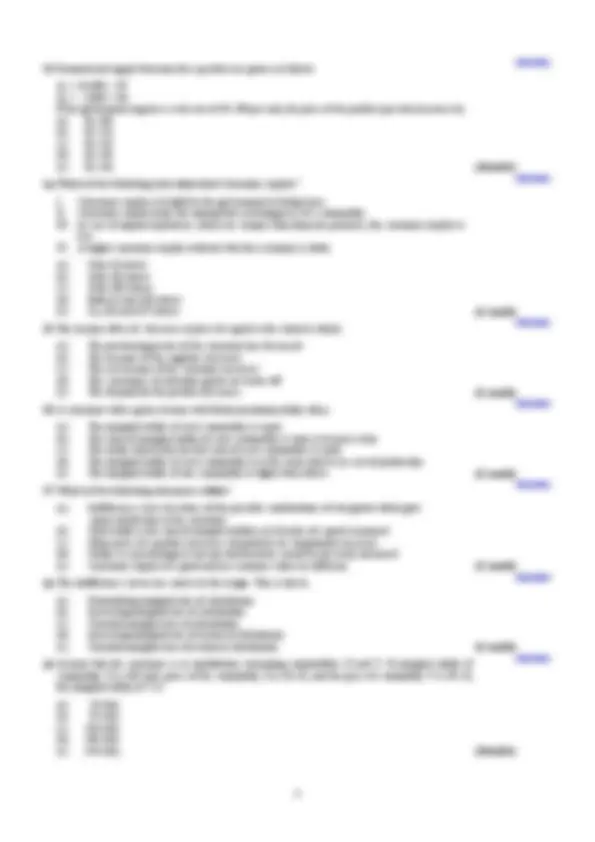
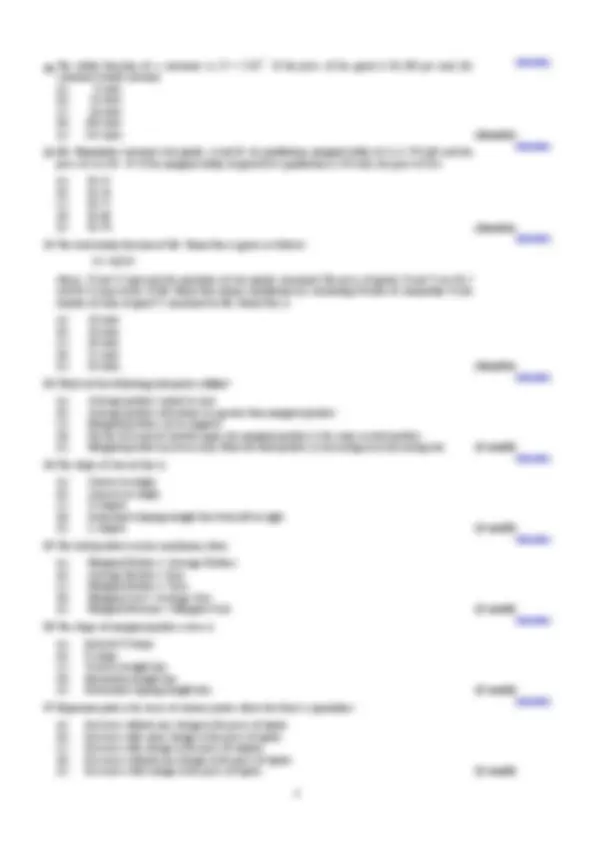
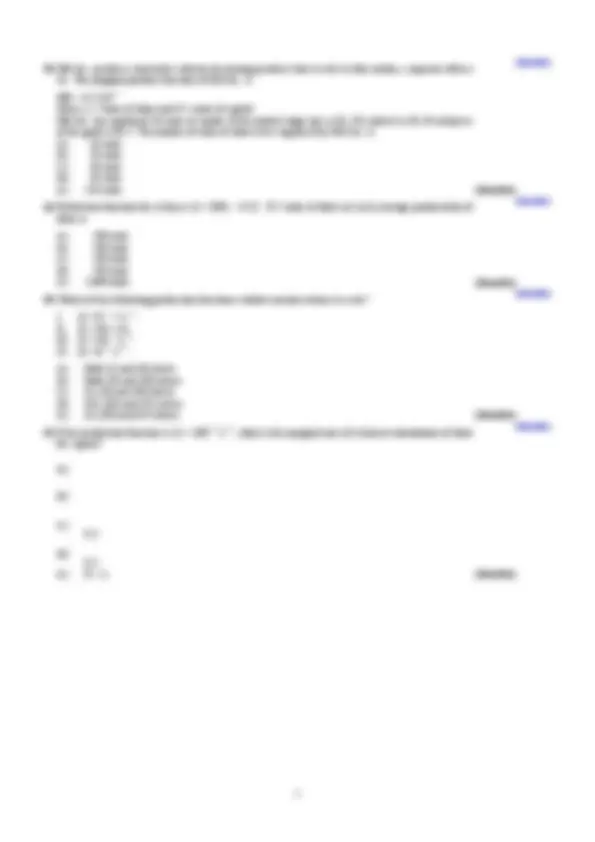
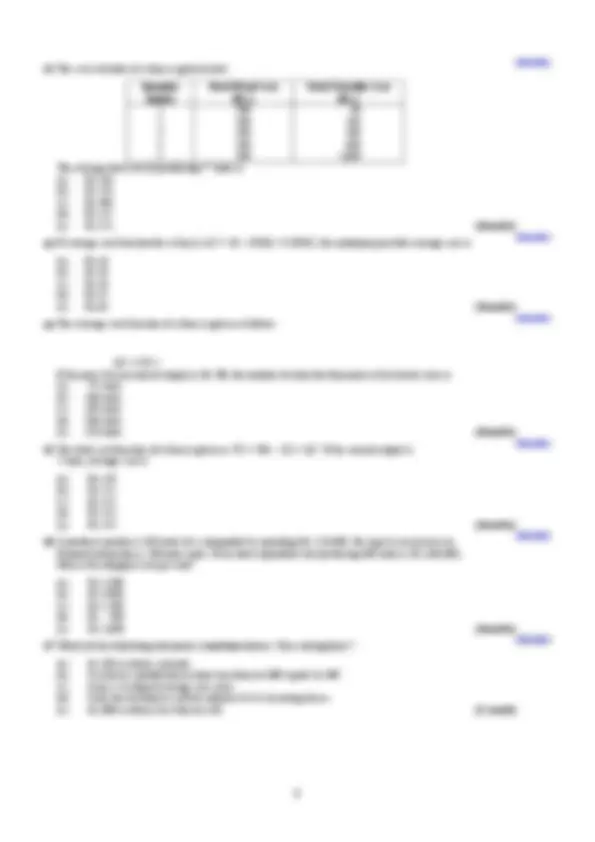
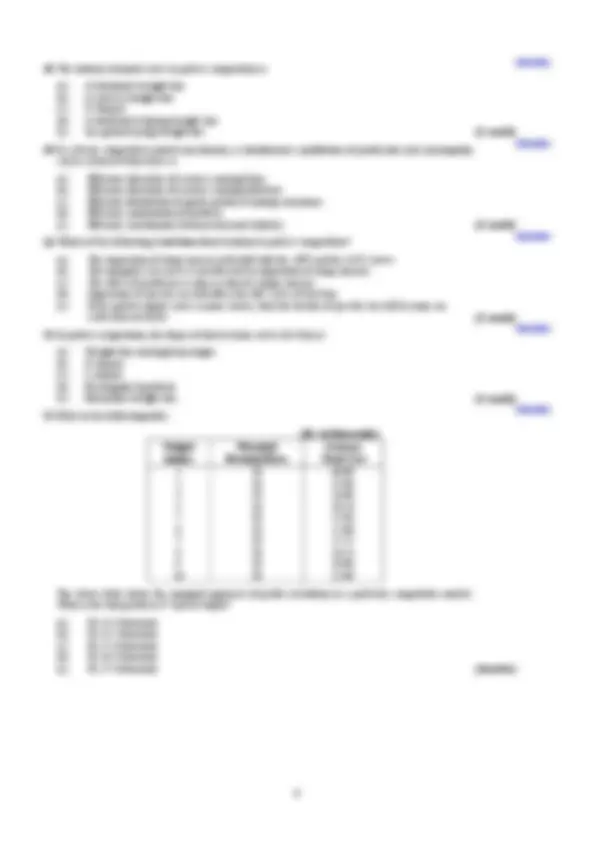
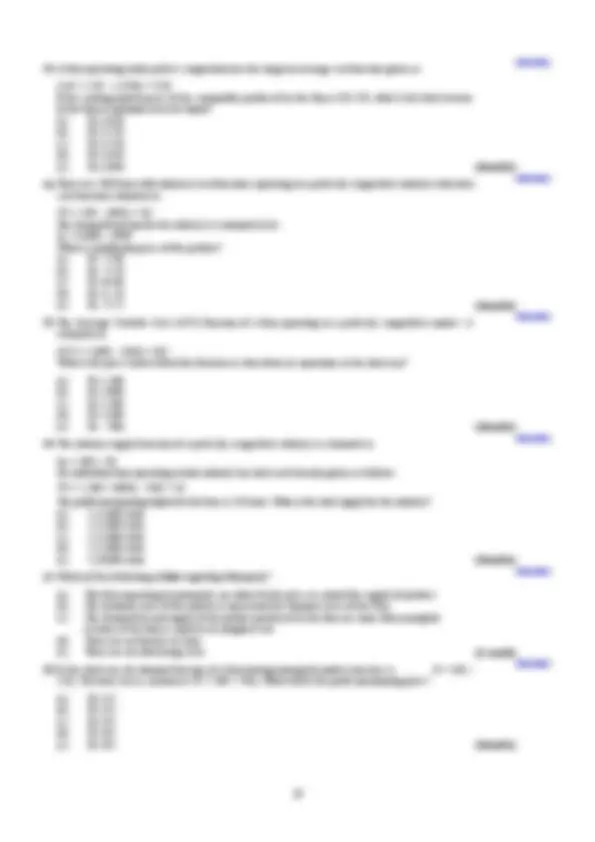
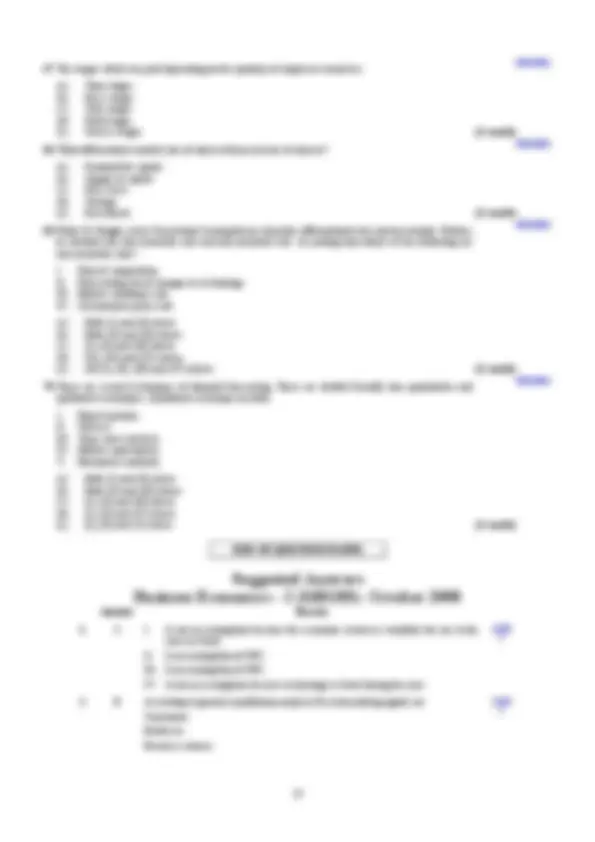
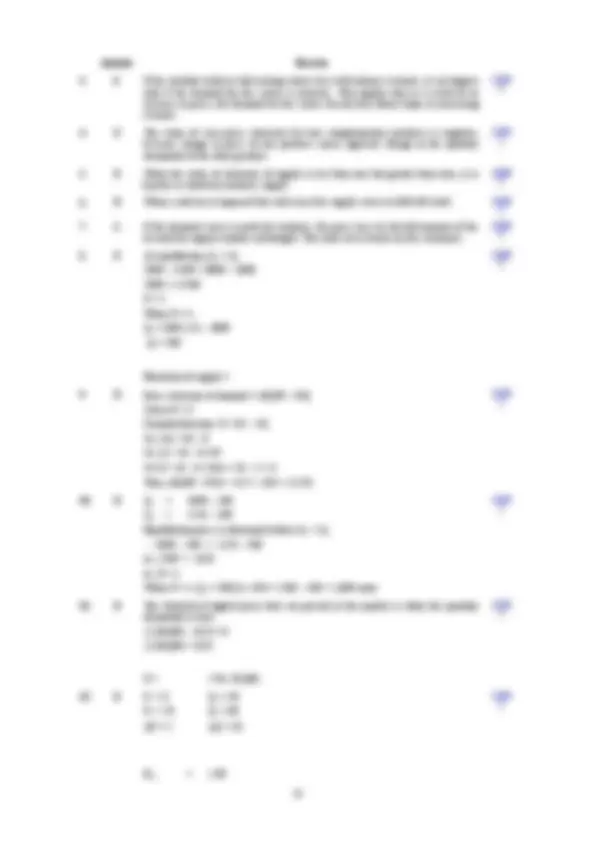
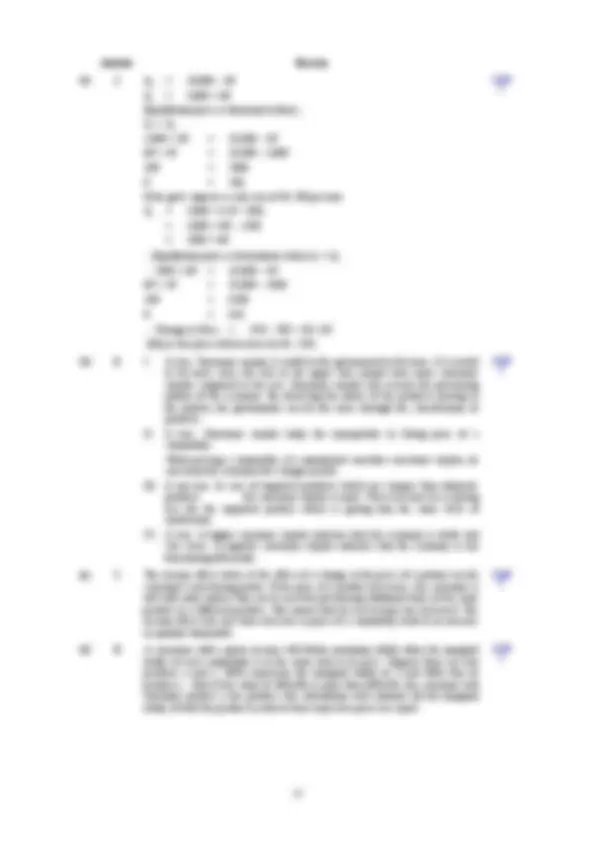
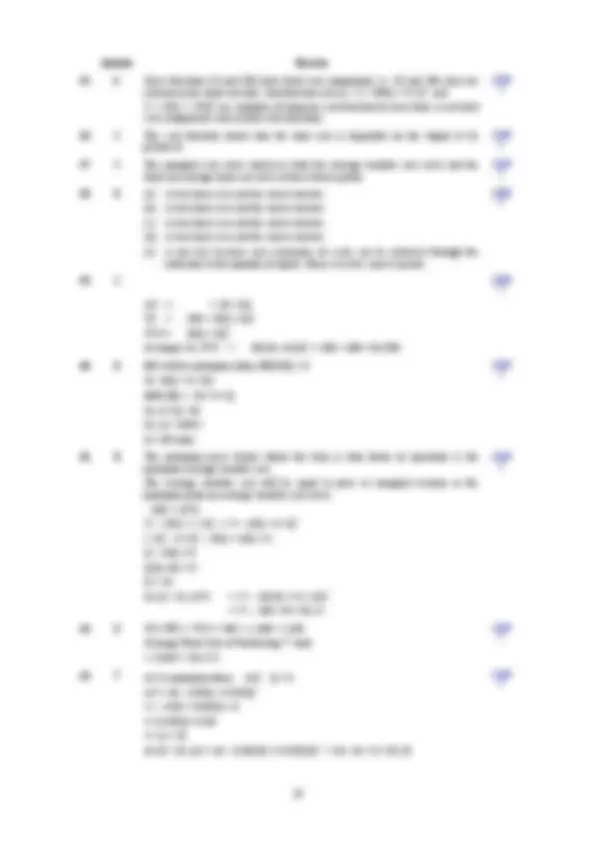
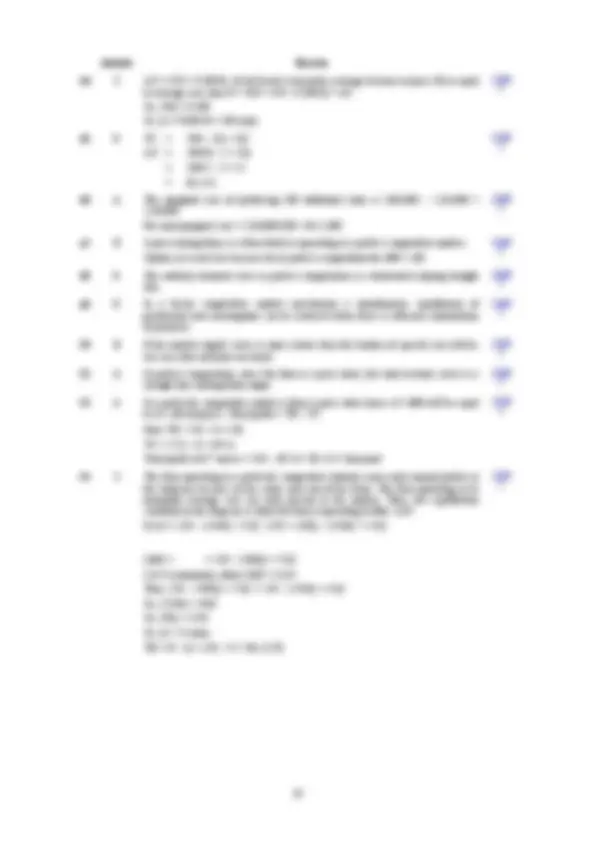
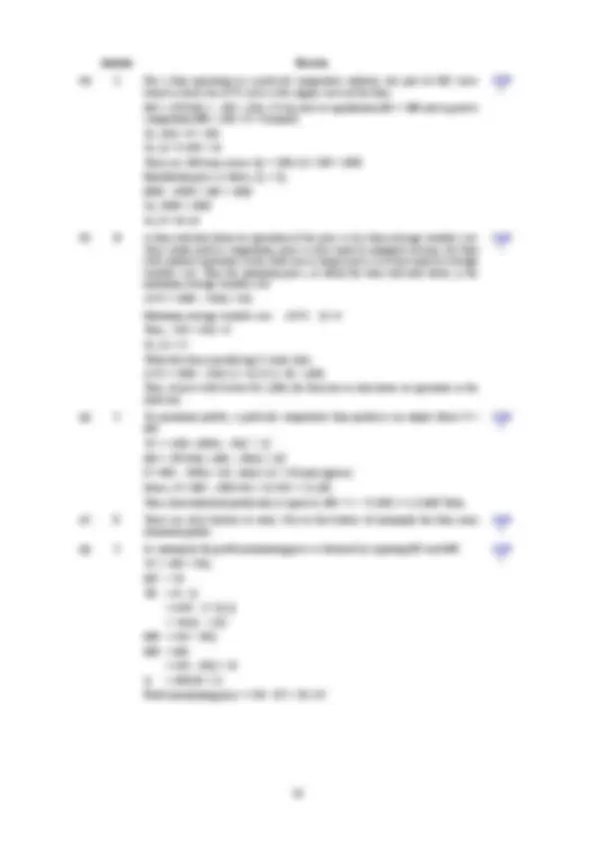
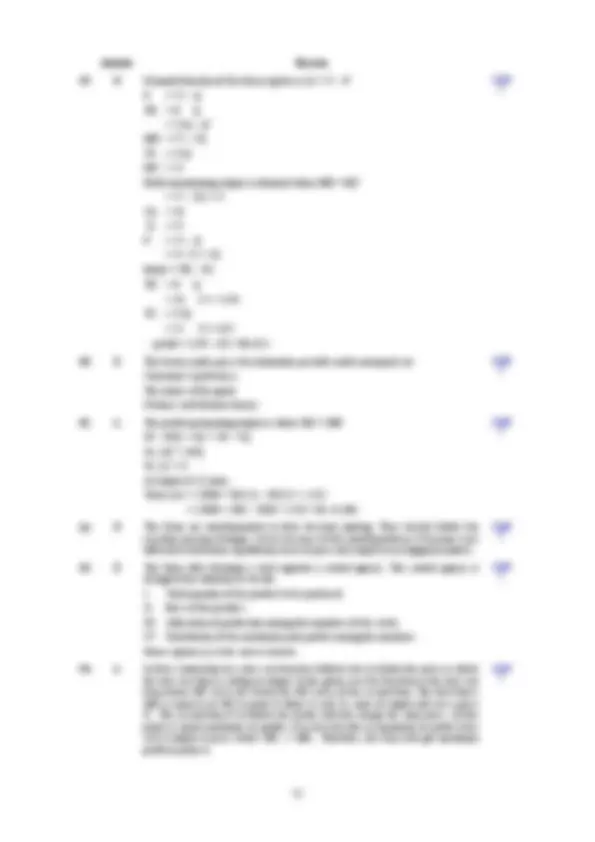
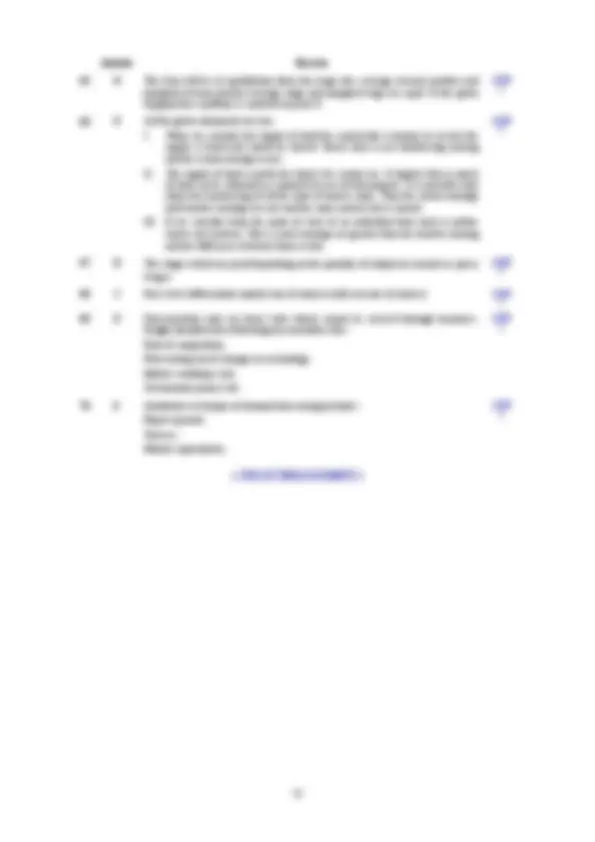


Study with the several resources on Docsity

Earn points by helping other students or get them with a premium plan


Prepare for your exams
Study with the several resources on Docsity

Earn points to download
Earn points by helping other students or get them with a premium plan
Community
Ask the community for help and clear up your study doubts
Discover the best universities in your country according to Docsity users
Free resources
Download our free guides on studying techniques, anxiety management strategies, and thesis advice from Docsity tutors
Various microeconomic concepts including elasticity of demand and supply, consumer and producer equilibrium, and different market structures such as perfect competition, monopoly, and oligopoly. It also includes various problems and their solutions related to these topics.
Typology: Study notes
1 / 22

This page cannot be seen from the preview
Don't miss anything!















Answer all 70 questions. Marks are indicated against each question. Total Marks : 100
1. Which of the following are not the assumptions made in constructing a Production Possibility Curve (PPC)? I. The economic resources available for use in the year are variable. II. The economic resources can be used to produce two broad classes of goods. III. Some inputs are better used in producing one of these classes of goods, rather than other. IV. Technology changes during the year. (a) Both (I) and (II) above (b) Both (I) and (III) above (c) Both (I) and (IV) above (d) Both (II) and (III) above (e) Both (III) and (IV) above. (1 mark)
2. According to general equilibrium analysis, who among the following is/are considered as decision making agent(s)? I. Consumers. II. Producers. III. Resource owners. (a) Only (I) above (b) Only (II) above (c) Only (III) above (d) Both (II) and (III) above (e) All (I), (II) and (III) above. (1 mark)
3. An educational institution is considering an increase in course fees of a particular course to enhance its revenue. If the institute expects that raising course fees would enhance revenue, then (a) It is ignoring the law of demand (b) It is assuming that the demand for the course is elastic (c) It is assuming that the supply of the course is elastic (d) It is assuming that the demand for the course is inelastic (e) It is assuming that the supply of the course is inelastic. (1 mark)
4. Which of the following statements is false?
(a) A change in demand, due to factors other than price is described as shift in demand curve (b) Demand tends to be more inelastic for those products that account for a small proportion of consumer’s total spending (c) Demand is more elastic in the long run than in the short run (d) Inferior goods have negative income elasticity (e) The value of cross-price elasticity for two complementary products is positive. (1 mark)
5. When the value of elasticity of supply is less than one but greater than zero, it is known as
(a) Perfectly elastic supply (b) Relatively elastic supply (c) Unitary elastic supply (d) Perfectly inelastic supply (e) Relatively inelastic supply. (1 mark)
6. When a unit tax is imposed, this will cause
(a) The supply curve to shift rightward (b) The supply curve to shift leftward (c) The demand curve to shift rightward (d) The demand curve to shift leftward (e) No change in the positions of demand and supply curves. (1 mark)
7. In which of the following situation(s) is the entire tax borne by the consumer?
I. If the demand curve is perfectly inelastic, the price rises by the full amount of the tax and the supply remains unchanged. II. If the supply curve is perfectly inelastic, there will be no increase in the price or decrease in supply. III. If the demand curve is perfectly elastic, the price does not rise at all. (a) Only (I) above (b) Only (II) above (c) Only (III) above (d) Both (I) and (II) above (e) Both (I) and (III) above. (1 mark)
8. The supply and demand functions of a commodity are estimated as
Q (^) d = 2,000 – 450P Q (^) s = 800P – 3,000. At equilibrium, the elasticity of supply for the commodity is (a) 2 (b) 4 (c) 6 (d) 8 (e) 16. (^) (2marks)
9. The demand function for a product is estimated as P = 40 – 4Q. If the current market price is Rs.8, what is the price elasticity of demand? (a) – 0. (b) – 0. (c) – 1. (d) 1. (e) 1.891. (2marks)
10. The demand and supply functions of a commodity are given as follows:
Q (^) s = 500P – 500 Q (^) d = 1,150 – 50P. The equilibrium output for the product is (a) 750 units (b) 1,000 units (c) 1,250 units (d) 1,400 units (e) 1,500 units. (^) (2marks)
11. The demand function for a commodity is estimated to be Q (^) d = 12,00,000 – 40P.The theoretical highest price that can prevail in the market is (a) Rs.90, (b) Rs.30, (c) Rs.10, (d) Rs.20, (e) Rs.40,000. (2marks)
12. The demand schedule of a perishable good is given below:
Price (Rs.) Quantity demanded (Units) 8 40 10 60 What is the arc price elasticity of demand? (a) 0. (b) 0. (c) 0. (d) 0. (e) 1.80. (2marks)
20. The utility function of a consumer is, U = 12X^
1.5 (^). If the price of the good is Rs.108 per unit, the consumer would consume (a) 9 units (b) 18 units (c) 36 units (d) 108 units (e) 144 units. (2marks)
21. Mr. Rammohan consumes two goods, A and B. At equilibrium, marginal utility of A is 250 utils and the price of A is Rs. 50. If the marginal utility of good B at equilibrium is 350 utils, the price of B is (a) Rs. (b) Rs. (c) Rs. (d) Rs. (e) Rs.70. (^) (2marks)
22. The total utility function of Mr. Rama Rao is given as follows:
U = 40XY where, X and Y represent the quantities of two goods consumed.The price of goods X and Y are Rs. and Rs.4 respectively. If Mr. Rama Rao attains equilibrium by consuming 40 units of commodity X, the number of units of good Y consumed by Mr. Rama Rao is (a) 10 units (b) 20 units (c) 30 units (d) 35 units (e) 40 units. (2marks)
23. Which of the following statements is false?
(a) Average product cannot be zero (b) Average product will always be greater than marginal product (c) Marginal product can be negative (d) For the first unit of variable input, the marginal product is the same as total product (e) Marginal product increases only when the total product is increasing at an increasing rate. (1 mark)
24. The shape of Isocost line is
(a) Convex to origin (b) Concave to origin (c) U-shaped (d) Downward sloping straight line from left to right (e) L-shaped. (1 mark)
25. The total product reaches maximum, when
(a) Marginal Product = Average Product (b) Average Product = Zero (c) Marginal Product = Zero (d) Marginal Cost = Average Cost (e) Marginal Revenue = Marginal Cost. (1 mark)
26. The shape of marginal product curve is
(a) Inverted U-shape (b) U-shape (c) Vertical straight line (d) Horizontal straight line (e) Downward sloping straight line. (1 mark)
27. Expansion path is the locus of various points where the firm’s expenditure
(a) Increases without any change in the price of inputs (b) Increases with some change in the price of inputs (c) Increases with change in the price of outputs (d) Decreases without any change in the price of inputs (e) Decreases with change in the price of inputs. (1 mark)
28. Hifi Inc. produces innovative interior decorating products that it sells to film studios, corporate offices etc. The marginal product function of Hifi Inc. is MP (^) L = 0.5LK0. where, L = units of labor and K = units of capital Hifi Inc. has employed 36 units of capital. If the market wage rate is Rs.120, interest is Rs.20 and price of the good is Rs.2. The number of units of labor to be employed by Hifi Inc. is (a) 10 units (b) 20 units (c) 30 units (d) 40 units (e) 120 units. (2marks)
29. Production function for a firm is Q = 200L – 0.2L^2. If 5 units of labor are used, average productivity of labor is (a) 100 units (b) 190 units (c) 198 units (d) 199 units (e) 1,000 units. (^) (2marks)
30. Which of the following production functions exhibit constant returns to scale?
I. Q = K 1/2^ + L1/2. II. Q = 3K + 4L. III. Q = 4K 1/2^ L1/2. IV. Q = K 1/2^ L2/3. (a) Both (I) and (II) above (b) Both (II) and (III) above (c) (I), (II) and (III) above (d) (II), (III) and (IV) above (e) (I), (III) and (IV) above. (2marks)
31. If the production function is Q = 10K 0.3^ L0.3^ , what is the marginal rate of technical substitution of labor for capital?
(a)
(b)
(c)
(d)
(e) K – L. (2marks)
37. Which of the following statements is true with regard to cost curves in the short run?
(a) The marginal cost curve intersects the average variable cost curve at its lowest point and the average total cost curve at its highest point (b) The marginal cost curve intersects the average variable cost curve at its highest point and the average total cost curve at its lowest point (c) The marginal cost curve intersects both the average variable cost curve and the average total cost curve at their lowest points (d) The marginal cost curve intersects both the average variable cost curve and the average total cost curve at their highest points (e) The marginal cost curve never intersects the average variable cost curve and the average total cost curve. (1 mark)
38. Which of the following statements is^ not true?
(a) The long run average cost is determined by economies of scales (b) When increase in production of one product leads to decrease in cost of production of another product, it is termed as economies of scope (c) Pecuniary economies of scale accrue to a firm when the firm gets discount due to large scale operation (d) Economies of scales are classified into internal and external economies of scales (e) Real economies of scale can be achieved through the increase in the quantity of inputs. (^) (1 mark)
39. For a firm, the average cost function is estimated as
What is total variable cost for the firm at an output of 10 units? (a) Rs. 102 (b) Rs. 864 (c) Rs. 900 (d) Rs.1, (e) Rs.1,400. (2marks)
40. A firm’s marginal cost function is estimated as follows:
MC = 50 – 30Q + 0.25Q 2. The output at which the marginal cost will be minimum is (a) 10 units (b) 15 units (c) 20 units (d) 30 units (e) 60 units. (2marks)
41. A firm operating under perfect competition has the following cost functions:
TC = 500 + 75Q – 10Q 2 + 0.5Q^3. The price below which the firm shut down its operations in the short-run is (a) Rs. (b) Rs. (c) Rs. (d) Rs. (e) Rs.75. (2marks)
42. The cost schedule of a firm is given below:
Quantity (units)
Total Fixed Cost (Rs.)
Total Variable Cost (Rs.) 1 200 60 2 200 160 3 200 360 4 200 660 5 200 1, The average total cost of producing 5th^ units is (a) Rs. (b) Rs. (c) Rs. (d) Rs. (e) Rs.252. (2marks)
43. If average cost function for a firm is AC = 36 – 0.80Q + 0.020Q^2 , the minimum possible average cost is
(a) Rs. (b) Rs. (c) Rs. (d) Rs. (e) Rs.64. (2marks)
44. The average cost function of a firm is given as follows:
If the price for one unit of output is Rs.500, the number of units the firm must sell to break-even is (a) 95 units (b) 100 units (c) 190 units (d) 200 units (e) 250 units. (2marks)
45. The total cost function of a firm is given as TC = 500 – 2Q + 3Q 2. If the current output is 5 units, average cost is (a) Rs. (b) Rs. (c) Rs. (d) Rs. (e) Rs.114. (2marks)
46. A producer produces 200 units of a commodity by spending Rs.1,50,000. He expects an increase in demand and produces 100 more units. If his total expenditure for producing 300 units is Rs.3,80,000, what is the marginal cost per unit? (a) Rs.2, (b) Rs.3, (c) Rs.1, (d) Rs. 500 (e) Rs.2,800. (2marks)
47. Which of the following statements is not true about a ‘Price taking firm’?
(a) Its AR is always constant (b) It achieves equilibrium in short run when its MR equals its MC (c) It has a U-shaped average cost curve (d) It has the freedom to exit the industry if it is incurring losses (e) Its MR is always less than its AR. (1 mark)
53. A firm operating under perfect competition has the long run average cost function given as:
LAC = 150 – 1,250Q + 25Q 2. If the existing market price of the commodity produced by the firm is Rs.150, what is the total revenue of the firm at optimum level of output? (a) Rs.3, (b) Rs.3, (c) Rs.3, (d) Rs.3, (e) Rs.3,980. (2marks)
54. There are 100 firms with identical cost functions operating in a perfectly competitive industry with total cost function estimated as: TC = 100 – 100Q + 5Q 2. The demand function for the industry is estimated to be: Q (^) d = 6,000 – 490P. What is equilibrium price of the product? (a) Rs. 9. (b) Rs. 9. (c) Rs.10. (d) Rs.11. (e) Rs. 9.75. (^) (2marks)
55. The Average Variable Cost (AVC) function of a firm operating in a perfectly competitive market is estimated as: AVC = 2,800 – 240Q + 8Q 2. What is the price below which the firm has to shut-down its operations in the short run? (a) Rs.1, (b) Rs.1, (c) Rs.1, (d) Rs.1, (e) Rs. 900. (2marks)
56. The industry supply function of a perfectly competitive industry is estimated as
Qs = 200 + 4P. An individual firm operating in that industry has total cost function given as follows: TC = 1,200 + 600Q – 50Q 2 + Q^3. The profit maximizing output for the firm is 150 units. What is the total supply for the industry? (a) 2,11,600 units (b) 2,12,000 units (c) 2,12,600 units (d) 2,11,000 units (e) 2,10,000 units. (2marks)
57. Which of the following is^ false^ regarding Monopoly?
(a) The firm operating in monopoly can either fix the price or control the supply of product (b) The demand curve of the market is represented by demand curve of the firm (c) The demand for and supply of the product produced by the firm are same when marginal revenue of the firm is equal to its marginal cost (d) There are no barriers to entry (e) There are no advertising costs. (^) (1 mark)
58. In the short run, the demand function of a firm having monopoly market structure is P = 440 – 15Q. The total cost is constant at TC = 200 + 50Q. What will be the profit maximizing price? (a) Rs. (b) Rs. (c) Rs. (d) Rs. (e) Rs.285. (2marks)
59. Alpha Ltd., has a monopoly in producing a product X. The demand function for this product is estimated as Q = 75 – P. The total cost function is TC = 25Q. What is the profit? (a) Rs. (b) Rs. (c) Rs. (d) Rs. (e) Rs.450. (2marks)
60. Which of the following factor(s) make price discrimination possible under monopoly?
I. Consumer’s preference. II. The nature of the good. III. Distance and frontier barrier. (a) Only (I) above (b) Both (I) and (II) above (c) Both (I) and (III) above (d) Both (II) and (III) above (e) All (I), (II) and (III) above. (^) (1 mark)
61. In the short run, a monopolistically competitive firm has the following cost and revenue functions:
TC = 15,000 + 30Q – 20Q 2 + Q^3 TR = 30Q – 2Q 2. If the firm is maximizing profits, what would be the total cost of the firm? (a) Rs. 14, (b) Rs. 14, (c) Rs. 14, (d) Rs. 14, (e) Rs. 14,108. (2marks)
62. Which of the following is^ not true^ regarding an oligopoly market?
(a) In this type of market, the firms produce either homogenous products or close substitutes (b) The firms are independent in their decision making (c) Economies of scale is one of the factors that limits the market to few sellers (d) Pricing decision of the firm depends on demand conditions, cost conditions and the pricing strategies of the rivals (e) Barriers to entry in oligopoly are much high. (^) (1 mark)
63. Which of the following are decided by the central agency in a Cartel?
I. Quantity to be produced. II. Price of the product. III. Allocation of production among the members. IV. Distribution of profits among the members. (a) Both (I) and (II) above (b) Both (III) and (IV) above (c) (I), (II) and (III) above (d) (I), (II) and (IV) above (e) All (I), (II), (III) and (IV) above. (1 mark)
67. The wages which are paid depending on the quantity of output are termed as
(a) Time wages (b) Piece wages (c) Task wages (d) Kind wages (e) Service wages. (1 mark)
68. What differentiates market rate of interest from real rate of interest?
(a) Demand for capital (b) Supply of capital (c) Price level (d) Savings (e) Investment. (1 mark)
69. Frank H. Knight, in his Uncertainty bearing theory of profit, differentiated risk and uncertainty. Further, he divided risk into insurable risk and non-insurable risk. According him which of the following are non-insurable risks? I. Risk of competition. II. Risk arising out of changes in technology. III. Market conditions risk. IV. Government policy risk. (a) Both (I) and (II) above (b) Both (II) and (III) above (c) (I), (II) and (III) above (d) (II), (III) and (IV) above (e) All (I), (II), (III) and (IV) above. (1 mark)
70. There are several techniques of demand forecasting. These are divided broadly into quantitative and qualitative techniques. Qualitative technique includes I. Expert opinion. II. Surveys. III. Time series analysis. IV. Market experiments. V. Barometric methods. (a) Both (I) and (II) above (b) Both (II) and (III) above (c) (I), (II) and (III) above (d) (I), (II) and (IV) above (e) (I), (II) and (V) above. (1 mark)
Answer Reason
1. C I. Is not an assumption because the economic resources available for use in the year are fixed. II. Is an assumption of PPC. III. Is an assumption of PPC. IV. Is not an assumption because technology is fixed during the year.
**< TOP
**
2. E According to general equilibrium analysis Decision making agents are Consumers. Producers. Resource owners.
**< TOP
**
Answer Reason
3. D If the institute believes that raising course fees will enhance revenue, it can happen only if the demand for the course is inelastic. This implies that as a result of an increase in price, the demand for the course do not fall, which helps in increasing revenue.
**< TOP
**
4. E The value of cross-price elasticity for two complementary products is negative, because change in price of one product causes opposite change in the quantity demanded of the other product.
**< TOP
**
5. E When the value of elasticity of supply is less than one but greater than zero, it is known as relatively inelastic supply.
**< TOP
**
6. B^ When a unit tax is imposed this will cause the supply curve to shift left ward.^ < TOP > 7. A If the demand curve is perfectly inelastic, the price rises by the full amount of the tax and the supply remains unchanged. The entire tax is borne by the customers.
**< TOP
**
8. E At equilibrium, Q (^) s = Q (^) d
2000 – 450P = 800P – 3000 5000 = 1250P P = 4. When P = 4, Q (^) s = (800 x 4) – 3000 Q (^) s = 200
Elasticity of supply =
**< TOP
**
9. B (^) Price elasticity of demand = Q/P P/Q
Given P = 8 Demand function: P = 40 – 4Q Or, 4Q = 40 – P Or, Q = 10 – 0.25P Or Q = 10 – 0.25(8) = 10 – 2 = 8 Thus, Q/P P/Q = -0.25 8/8 = -0.250.
**< TOP
**
10. B Q (^) s = 500P – 500
Q (^) d = 1150 – 50P Equilibrium price is determined when Q (^) s = Q (^) d. 500P – 500 = 1150 – 50P or, 550P = 1650 or, P = 3 When P = 3, Q (^) s = 500(3) –500 = 1500 – 500 = 1,000 units.
**< TOP
**
11. B The theoretical highest price that can prevail in the market is when the quantity demanded is zero. 12,00,000 – 40 P = 0 12,00,000 = 40 P
P = = Rs. 30,000.
**< TOP
**
E (^) Pd = 1.
**< TOP
**
Answer Reason
17. C (a) True. Indifference curve is various combinations of two goods which give the same level of total utility (b) True. Total utility is the sum of marginal utilities of all the goods consumed. (c) False. When price of a product increases demand for the product decreases. As complimentary goods are consumed together, demand for the compliment also decreases. (d) True. Utility is subjective and varies from individual to individual and from time to time for the same individual, hence cannot be measured precisely. (e) True. Consumer surplus is the difference between what the consumer is willing to pay and what he actually pays. Economic value is the market value of a good.
**< TOP
**
18. A^ The indifference curve is convex to the origin. It follows from the assumption that the marginal rate of substitution of X for Y (MRSxy) diminishes as more and more of X is substituted for Y. Only a convex indifference curve can mean a diminishing marginal rate of substitution of X for Y.
**< TOP
**
At equilibrium =
MU (^) y= 10 = 140 utils.
**< TOP
**
20. C The consumer would consume the good up to a point where MU = P.
TU = 12X 1. MU = 18X 0.5^ = 108 X 0.5^ = 6 Or, X = 36 units.
**< TOP
**
That gives 250/50 = 350/ P (^) B
or P (^) B = = Rs.70.
**< TOP
**
22. B Total utility = U = 40XY
MU (^) X = U/ X = 40Y MU (^) Y = U/ Y = 40X At equilibrium, MU (^) X /P (^) X = MU (^) Y /P (^) Y 40Y/2 = 40X/ Or, 20Y = 10X Or, 2Y = X Thus, if X = 40, Y = X/2 = 40/2 = 20 units.
**< TOP
**
23. B Option (b) is false because the average product will be greater than marginal product only after the point when both of them are equal. Before this point the marginal product will greater than average product.
**< TOP
**
24. D An isocost line is a straight line sloping downward from left to right. < TOP > 25. C Total product reaches maximum position when marginal product is zero. When AP = MP, AP will be at maximum. When AC = MC, AC will be at minimum. Hence the correct answer is (c).
**< TOP
**
26. A The marginal product of a factor increases first and after reaching a certain level it starts falling. So due to this the marginal product curve assume an inverted u shape.
**< TOP
**
Answer Reason
27. A Expansion path is the locus of different points where the firm’s expenditure increases without any change in the price of inputs.
**< TOP
**
28. B MP (^) L = 0.5L (36) 0.5^ = 3L
W = MP (^) L × P (W is the market wage rate). 120 = 3L × 2 Or, L = 20 units.
**< TOP
**
29. D The production function for a firm Q = 200L – 0.2L 2
When L = 5, APL = 200 – 0.2(5) = 200 – 1 = 199 units.
**< TOP
**
When K = 1 and L = 1, Q = (1) 1/2^ + (1) 1/2^ = 2 When K = 2 and L = 2, Q = (2) 1/2^ + (2) 1/2^ = 2. When inputs are doubled, output are less than doubled. It is a case for decreasing returns to scale. II. Q = 3K + 4L When K = 1 and L = 1, Q = 3 + 4 = 7 When K = 2 and L = 2, Q = 6 + 8= 14 When inputs are doubled, output are also doubled. It is a case of constant return to scale. III. Q = 5K 1/2^ L1/ When K = 1 and L = 1, Q = 5(1) 1/2^ (1) 1/2^ = 5 When K = 2 and L = 2, Q = 5 (2) 1/2^ (2) 1/2^ = 10 It is a constant return to scale. IV. Q = K 1/2^ L2/ When K = 1 and L = 1, Q = (1) 1/2. (1) 2/3^ = 1 1 = 1 When K = 2 and L = 2, Q = (2) 1/2^ (2) 2/3^ = 1.41 1.58 = 2. It is an increasing return to scale.
**< TOP
**
31. A The MRTS is equal to the ratio of the marginal productivities of the two products that is MP (^) K /MP (^) L 3K -0.7^ L0.3^ /3K 0.3^ L-0. K -0.7^ L0.3^ /K0.3^ L-0. L/K.
**< TOP
**
32. E The average variable cost is equal to 150 – 25Q + 30Q 2
The average fixed cost is equal to 1200/Q.
**< TOP
**
33. D As the fixed cost is fixed at all points, the shape of the curve is horizontal straight line.
**< TOP
**
34. C Average fixed cost is calculated as total fixed cost divided by the number of output produced. It always declines as output increases. Even if the firm produces zero output, the average fixed cost will be positive because total fixed cost is constant. (a) Is not the answer because if a firm produces zero output in the short period, its total cost will not be zero because total fixed cost is constant. (b) Is not the answer because its variable cost will not be positive. (c) Is the answer because its fixed cost will be positive (d) Is not the answer because average cost will not be zero rather it will be a positive number. (e) Is not the answer because fixed cost will never be negative.
**< TOP
**
Answer Reason
44. C AC = 450 + 9,500/Q. At the break-even point, average revenue or price (P) is equal to average cost, thus P = 500 = 450 + 9,500/Q = AC. Or, 50Q = 9, Or, Q = 9500/50 = 190 units.
**< TOP
**
= Rs.113.
**< TOP
**
46. A The marginal cost of producing 100 additional units is 3,80,000 – 1,50,000 = 2,30, Per unit marginal cost = 2,30,000/100 = Rs.2,
**< TOP
**
47. E^ A price taking firms is a firm which is operating in a perfect competitive market.
Option (e) is not true because the in perfect competition the MR = AR
**< TOP
**
48. D The industry demand curve in perfect competition is a downward sloping straight line.
**< TOP
**
49. D^ In^ a^ freely^ competitive^ market^ mechanism^ a^ simultaneous^ equilibrium^ of production and consumption can be achieved when there is efficient combination of products.
**< TOP
**
50. E If the market supply curve is more elastic then the burden of specific tax will be less on seller and more on buyer.
**< TOP
**
51. A In perfect competition, since the firm is a price taker, the total revenue curve is a straight line starting from orgin.
**< TOP
**
52. A In a perfectly competitive market a firm is price taker hence it’s MR will be equal to it’s AR and price. Total profit = TR – TC Here TR = 20 6 = 120 TC = 17.6 6 = 105. Total profit of 6 th^ unit is = 120 – 105.6 = Rs.14.4. thousand
**< TOP
**
53. C The firm operating in a perfectly competitive industry earns only normal profits in the long run because of free entry and exit of the firms. The firm operating at its minimum average cost can only prevail in the market. Thus, the equilibrium condition in the long run is when the firm is operating at Min. LAC. If AC = 150 – 1250Q + 25Q 2 LTC = 150Q – 1250Q 2 + 25Q 3
LAC is minimum, when LMC = LAC Thus, 150 – 2500Q + 75Q 2 = 150 – 1250Q + 25Q 2 Or, 1250Q = 50Q 2 Or, 50Q = 1250 Or, Q = 25 units. TR = P Q = 150 25 = Rs.3,750.
**< TOP
**
Answer Reason
54. C For a firm operating in a perfectly competitive industry, the part of MC curve which is above the AVC curve is the supply curve of the firm. MC = TC/Q = - 100 + 10Q = P (because at equilibrium MC = MR and in perfect competition MR = AR = P = Demand) Or, 10Q = P + 100 Or, Q = 0.10P + 10 There are 100 firms, hence Qs = 100x Q = 10P + 1000 Equilibrium price is where, Q (^) s = Q (^) d 6000 – 490P = 10P + 1000 Or, 500P = 5000 Or, P = Rs.
**< TOP
**
55. B A firm will shut down its operations if the price is less than average variable cost. Since under perfect competition, price is also equal to marginal revenue, the firm will continue operations in the short run so long as price is at least equal to average variable cost. Thus the minimum price, at which the firm will shut down, is the minimum average variable cost. AVC = 2800 – 240Q + 8Q 2 Minimum average variable cost: AVC/ Q = 0 Thus, -240 + 16Q = 0 Or, Q = 15 When the firm is producing 15 units, then AVC = 2800 – 240(15) + 8(225) = Rs. 1,000. Thus, if price falls below Rs.1,000, the firm has to shut-down its operation in the short run.
**< TOP
**
56. C^ To maximize profits, a perfectly competitive firm produces an output where P = MC TC = 1200 + 600Q – 50Q 2 + Q^3 MC = TC/Q = 600 – 100Q + 3Q 2 P = 600 – 100Q + 3Q 2 , where Q = 150 units (given) Hence, P = 600 – 100(150) + 3(150) 2 = 53, Thus, total industrial production is equal to (200 + 4 53,100) = 2,12,600 Units.
**< TOP
**
57. D^ There are strict barriers to entry. Due to this feature of monopoly the firm earns abnormal profits.
**< TOP
**
58. C^ In monopoly the profit maximizing price is obtained by equating MC and MR.
TC = 200 + 50Q MC = 50 TR = P Q = (440 – 15 Q) Q = 440Q – 15Q 2 MR = 440 – 30Q MR = MC = 440 – 30Q = 50 Q = 390/30 = 13. Profit maximizing price = 440 –195 = Rs.
**< TOP
**